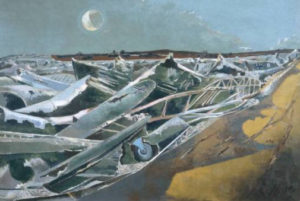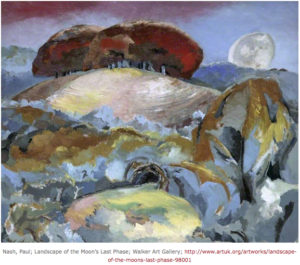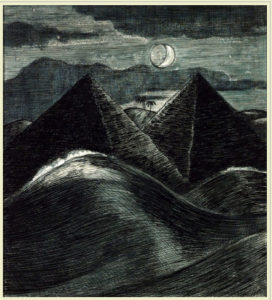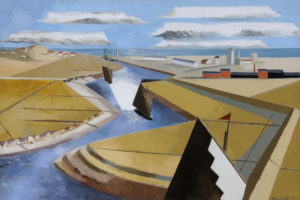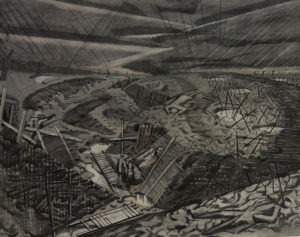John Nash at Tate Britain, October 2016-March2017 (p7)
Wars
How lucky we are, I mean those who lived through the ‘trente glorieuses’, those who were spared world wars, at least during their years of consciousness. It tends to be also those who endorse the European Union despite all its faults, simply because Europeans have refrained from using arms against each other – contrary to Europe’s long history of bloody wars – since the inception of what has become the European Union.
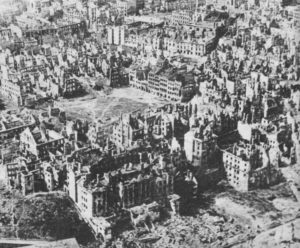 Warsaw destroyed, source: Wikimedia
Warsaw destroyed, source: Wikimedia
Paul Nash’s experience of wars
Paul Nash witnessed both world wars, including as an official war artist. It is hard to imagine how this must have affected his mind. Post traumatic stress disorder was not recognised during the first world war, when many among those who were affected by the horrors of war were condemned as deserters. Even during the second world war, those called up to defend their country were expected to fight on, regardless. Paul Nash’s paintings are witnessing their conditions in the trenches and in the battle fields. His most haunting paintings are commemorating war in more abstract terms, probably painted with hindsight. ‘Void’ is an example of a retrospective of the first world war, painted in 1918. ‘Totes Meer’ (dead sea) painted in 1940 may be an anticipation of second world war destruction still to come.
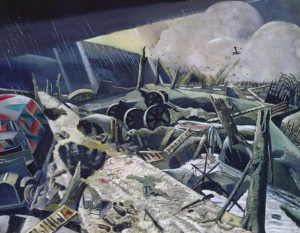 Paul Nash, Void, 1918, source: https://gerryco23.files.wordpress.com/2014/02/paul-nash
Paul Nash, Void, 1918, source: https://gerryco23.files.wordpress.com/2014/02/paul-nash
http://www.rennart.co.uk/images/nash
Wars, cities and nature
The wars were, and are destroying everywhere and everything. Prime strategic targets, ports, airports, factories, seats of power brought demolition to cities. The urban fabric got destroyed and with it many people still living and continuing to work in cities. Paul Nash recorded the effects of wars in the countryside. He was fascinated by the destruction of nature and its power to restore itself in the middle of war desolation. The cities were far less resilient. Like in the trenches people died, were maimed, their minds damaged for life, but cities had to rely on human endeavour for their reconstruction, something which did not attract Nash’s attention.
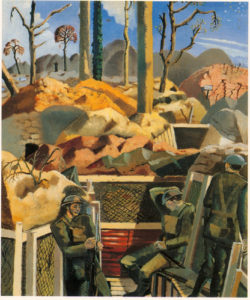 Paul Nash, Spring in the trenches, 1917, source: https://www.pinterest.com/pin/66639269457269426/
Paul Nash, Spring in the trenches, 1917, source: https://www.pinterest.com/pin/66639269457269426/
Inspirations from home and abroad
Nash died soon after the second world war and his last paintings had nothing to do with war. In some way they recall the symbolism of his early work, his fascination with elements out there, the moon, the sun, wildlife, tree cops. Before the first world war his paintings and drawings accompanied by his poems were romantic and somewhat dark, influenced by the Pre-Raphaelites and also by William Blake and his mysticism.
https://wse999.wordpress.com/category/art/
http://fridaynightboys300.blogspot.co.uk/2016/11/paul-nash-at-tate-britain.html
It could be argued that at that time his work belonged to English art. After the war, he concentrated on landscapes, under the influence of painters outside the United Kingdom. He was interested in surrealism although his paintings seem to be inspired just as much by constructivism and cubism of Braque and Picasso, with whom he also shared a colour palette. He collected objects on beaches and painted them as ‘natures mortes’. Was that his way of overcoming his war experience?
http://www.rennart.co.uk/images/nashryemarshes
Despite his many diverse excursions into styles of painting, poetry, photography and writing, shown comprehensively in the retrospective exhibition at Tate Britain in London from October 2016 to March 2017, Paul Nash remains best known for his war paintings which are on permanent show at the Tate and in other UK museums and galleries.
https://gerryco23.files.wordpress.com/2014/02/paul-nash-after-the-battle-

